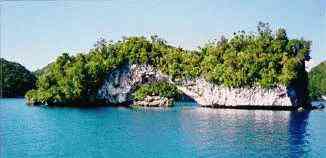
HOME
What's New?
Useful Sites
Visitor's Authority
Palau Map
Miscellanious Sites
Preservation Society
Getting Around
KB Bridge
Diving Tips
The Famous Blue Corner
Living Legacy
Being A Palauan
Proverbs
Palauan Horoscope
Personal Homepages
The Cube
Palauan Links
About YDKDY

| Palau's 'rock islands' are humps of rounded, coralline limestone, thickly covered with forest, dropping steeply into the quiet, blue-green water of the channels that wend among them. There is nothing like them anywhere else in the Micronesia. Some are no larger than a tabletop; other may be a mile or more in length. All are undercut where their stony sides meet the water. Wave action and a coral-eating chiton hollow the rock for as much as two or three feet above the water, making a curious indentation. |
|
The Palau lagoon, through which the rock islands are scattered, is bursting with marine life.
A meal of seafood can be taken casually from its waters, and even an idle afternoon's cruise is likely to startle rays from their resting places, discover sharks or other large fish, or reveal languish sea turtles. A potrion of the rock islands known as Seventy Islands has been set aside as a conservation area under the mandate from the Palauan government. On the beaches of those islands sea turtles lay their eggs. Two months later up to 150, inch-long, soft-shelled turtles scramble from each nest and scuttle for the lagoon waters.
They incubate in a sandy nesthole, laved by occasional tides, and warmed by the sun. The turtles are threatened by plant roots that may penetrate the nest and drip rainwater on the eggs, by tunneling crabs, and poachers which breaks into the nests and steal eggs. Because Hawksbill turtles are diminishing in number, the Palauan government has launched a preservation program.
Conservation officers carefully open the nests, estimate the degree of maturation of the eggs, cover and mark the nest, then return when the turtles have hatched. The small turtles are taken to Koror, Palau Mariculture, where they are raised to nearly six inches. Tough-shelled by then, and able to avoid the fish that would eat them as infants, they are released into Palauan waters to multiply.
